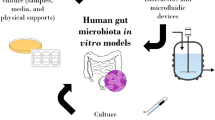Summary
We have developed methods for the culture of human endometrial glandular epithelia in vitro. The culture medium is serum-free and is used in combination with Matrigel, an extracellular matrix material applied as a coating on cell culture plates. Cell growth begins as a monolayer, but the cells subsequently form glandular or organoid structures. The glands are composed of polar columnar cells facing a central lumen, which is enclosed by the apical surfaces of cells displaying numerous microvilli and sealed by tight junction complexes. The ability to study in vitro the complex process of glandular morphogenesis represents an important new tool in cell biology which may be used to investigate growth regulation, hormone production and dependency, and cellular recognition and interactions. Ultimately, these characteristics may be applied to study the alterations of glandular epithelia associated with neoplasia.
Similar content being viewed by others
References
Centola, G. M.; Cisar, M.; Knab, D. R. Establishment and morphologic characterization of normal human endometrium in vitro. In Vitro 20:451–462; 1984.
Chen, L.; Linder, H. R.. Mitogenic action of oestradiol 17-β on human myometrial and endometrial cells in long-term tissue cultures. J. Endocrinol. 59:87–97; 1973.
Davis, G. E.; Blaker, S. N.; Engvall, E., et al. Human amnion membrane serves as a substrate for growing axons in vitro andin vivo. Science 236:1106–1109; 1987.
Hadley, M. A.; Byers, S. W.; Suarez-Quian, C. A., et al. Extracellular matrix regulates sertoli cell differentiation. J. Cell Biol. 101:1511–1522; 1987.
Hiratsu, T..In vitro cultivation of human endometrium and the influence of steroid hormones on a cell line derived from the endometrium. Kobe J. Med. Sci. 14;19–48; 1968.
Kirk, D.; Alvarez, R. B. Morphologically stable epithelial vesicles cultured from normal human endometrium in defined media. In Vitro 22:604–614; 1986.
Kirk, D.; King, R. B. J.; Heyes, J., et al. Normal human endometrium cell culture. I. Separation and characterization of epithelial and stromal components in vitro. In Vitro 14: 651–662; 1978.
Kleinman, H. K.; McGarvey, M. L.; Hassel, J. R., et al. Basement membrane complexes with biological activity. Biochemistry 25:312–318; 1986.
Lewis, P. R.; Knight, D. P., eds. Staining methods for sectioned material. Amsterdam, Netherlands: Elsevier; 1977:47–53.
Lisczak, T. M.; Richardson, G. S.; MacLaughlin, D. T., et al. Ultrastructure of human endometrial epithelium in monolayer culture with and without steroid hormones. In Vitro 13:344–356; 1977.
Madison, R.; DaSilva, C. F.; Dikkes, P., et al. Increased rate of peripheral nerve regeneration using bioresorbable nerve guides and a laminin coated gel. Exp. Neurol. 88:767–772; 1985.
Noumoff, J. M.; Haydock, S. W.; Sachdeva, R., et al. Characteristics of cell lines derived from normal and malignant tissue. Gynecol. Oncol. 27:141–149; 1987.
Ormerod, E. J.; Rudland, P. S. Mammary gland morphogenesisin vitro: formation of branched tubules in collagen gels by a cloned rat mammary cell line. Dev. Biol. 91:360–375; 1982.
Ormerod, E. J.; Rudland, P. S. Mammary gland morphogenesis in vitro: extracellular requirements for the formation of tubules in collagen gels by a cloned rat mammary epithelial cell line. In Vitro 24:17–27; 1988.
Satyaswaroop, P. G.; Bressler, R. S.; de la Pena, M. M., et al. Isolation and culture of human endometrial glands. J. Clin. Endocrinol. Metab. 48:639–641; 1979.
Siegfried, J. M.; Nelson, K. G.; Martin, J. L., et al. Histochemical identification of cultured cell from human endometrium. In Vitro 20:25–32; 1984.
Trent, J. M.; Davis, J. R.; Payne, C. M. The establishment and morphologic characterization of finite cell lines from normal human endometrium. Am. J. Obstet. Gynecol. 136:356–362; 1980.
Varma, V. A.; Melin, S. A.; Adamec, T. A., et al. Monolayer culture of human endometrium: methods of culture and identification of cell types. In Vitro 18:911–918; 1982.
Way, D. L.; Grosso, D. S.; Davis, J. R. et al. Characterization of a new human endometrial carcinoma (RL95-2) established in tissue culture. In Vitro 19:147–158; 1983.
Yang, J.; Richards, J.; Guzman, R., et al. Primary culture of human mammary epithelial cells embedded in collagen gels. JNCI 65:337–343; 1980.
Yang, N. S.; Kube, D.; Park, C., et al. Growth of human mammary epithelial cells on collagen gel surfaces. Cancer Res. 41:4093–4100; 1981.
Author information
Authors and Affiliations
Additional information
This work was supported by NIH grants CA31733 and CA09156 and NIEHS contract ES55092
Rights and permissions
About this article
Cite this article
Rinehart, C.A., Lyn-Cook, B.D. & Kaufman, D.G. Gland formation from human endometrial epithelial cells in vitro. In Vitro Cell Dev Biol 24, 1037–1041 (1988). https://doi.org/10.1007/BF02620878
Received:
Accepted:
Issue Date:
DOI: https://doi.org/10.1007/BF02620878




